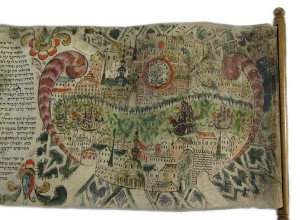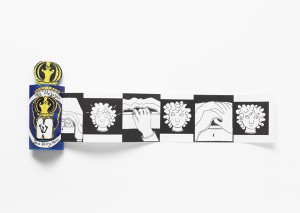
Detail of a Megillah, Germany, 18th century
© Jewish Museum Berlin. Photo: Michaela Roßberg
Today, 16 March, Jewish communities are celebrating Purim. On this holiday, the biblical Book of Esther is read aloud in synagogue. In keeping with tradition, the story of Esther—who saves the Jewish people in the Persian Empire from destruction by Haman, the king’s highest-ranking official—is read not from a book but from a parchment scroll. Commenting on the (Hebrew) reading, noisy hoots and rattles are sounded. (Alternative customs are described in our blog text for last year’s Purim).
Numerous Esther scrolls are currently in the custody of the Jewish Museum. The 32 works on loan will be on display along with other historical manuscripts from 4 April 2014, in the special exhibition “The Creation of the World. Illustrated Manuscripts from the Braginsky Collection.” → continue reading
Opening this Friday at the Eric F. Ross Gallery
Fred Stein is a photographer whose work and biography leave no one unmoved. Some of his portraits are famous—those of Albert Einstein and Hannah Arendt for example—yet Fred Stein himself is not a household name. The young lawyer was forced to flee Germany in 1933. He went first to Paris, and then in 1941 to New York. In these cities of exile he made photography his new profession, producing numerous street scenes and portraits.
“In An Instant” struck us as an apt title for the exhibition of his extensive oeuvre scheduled to open at the Jewish Museum Berlin on 22 November. This title highlights Fred Stein’s talent for capturing his subjects at the decisive moment, spontaneously, and without elaborate preparations—a natural talent, incidentally, for he was a self-taught amateur.
Fred Stein’s special gift of observation is evident in the photograph “Little Italy” (New York, 1943), one of our many favorites. → continue reading
Since the end of August visitors to the permanent exhibition have been able to purchase small artworks from an ‘art vending machine.’ The artworks have been created by Jewish artists living and working in Berlin.

Paper mezuzah with pull-out comic strip by Zara Verity Morris
© Jewish Museum Berlin, photo: Jens Ziehe
Today we present one of the artists: Zara Verity Morris from London. Morris is currently studying for her Masters degree at the “Institute for Art in Context,” at the Berlin University of the Arts. For the art vending machine she has created a comic strip called “The Mezuzah” on a pull-out paper scroll. (A mezuzah is a small case, which is attached to the door posts of Jewish households. Inside is a handwritten parchment scroll with the Hebrew prayer “Shema Yisrael” (“Hear O Israel”).
Christiane Bauer: Zara, can you for starters briefly explain to me why you produced this particular object for the art vending machine?
Zara Verity Morris: I found it an interesting challenge to play with the limited space of the art vending machine, and wanted to make something that could be unfolded once it has been taken out. The long paper roll was inspired by the formal connection between the Torah and a mezuzah.
When I was a young child, I found a few mezuzot in a drawer in varying conditions. A few had open cases. I was surprised to discover a paper scroll lying inside one of them with Hebrew writing on it. I was excited, and thought it was like a toy Torah. As a child, one of my favourite parts of being at a service at synagogue was the heavy Torah being ‘undressed’ by two people; getting its velvet cover and decorations taken off to reveal the plain paper scroll underneath. I decided to turn these childhood memories into a comic.
How does “The Mezuzah” fit into your previous work? → continue reading

